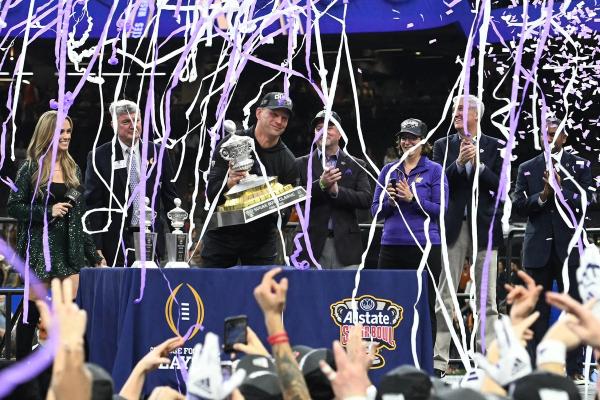🌹 The origin story
There are two tiers of college football that handle their postseasons very differently: the lower-tier Football Conference Subdivision’s championship, which follows a traditional bracket-style format, and the elite Football Bowl Subdivision (FBS), which does a little bit of everything.
- The FBS hosts independent postseason matchups, where contenders are handpicked for all-or-nothing contests called bowl games.
Bowl games go way back. The Tournament of Roses Association created the first college football bowl game, aka the Tournament East-West Football Game, as part of its annual festival in 1902 — four years before the NCAA was even created.
- In 1923, the Association moved the matchup to its new home, the brand-new Rose Bowl stadium in Pasadena, CA, named for its bowl shape. And so, the Rose Bowl Game, aka “the Granddaddy of Them All,” was born.
- Other cities wanted in on the massive crowds and nationwide attention the Rose Bowl drew to Pasadena, so they set up their own postseason games and festivals. By 2000, 25 cities hosted matchups, all using the “bowl” moniker.
Things really took off in the new millennium, as blue chip companies increasingly saw bowl games as marketing opportunities. In the past 20 years, there’s been an explosion in the number of games (currently a head-spinning 47), the money behind them, and, the baffling, meme-worthy names title sponsors give them.
Bowl games have been a staple of the football postseason for a century, even as the methods of determining the true national champion have changed. Some are more prestigious than others, but they’re all part of what makes college football special.
🏈 The impact

Source: BowlSeason/X
If the NCAA doesn’t sponsor bowl games, then why do they matter? First, bowl games and the CFP generate a lot of money for their host cities. Last year, Houston received an economic boost of $200M for hosting the championship game.
- The teams also have a lot at stake: Even the most obscure bowl games offer hundreds of thousands in winnings with the 2023 payouts ranging from $225K to over $8M.
This year’s new 12-team playoff format (more on that below) will feature some truly eye-watering payouts. To start, each playoff-bound school’s conference gets a cute $4M for qualifying and an additional $3M to cover expenses for each round.
- Semifinalists will each receive $6M with another $6M going to the championship contenders. That’s a big chunk of change.
But teams don’t just play for the money. In college football, the only thing worth more than a payout is clout, and being invited to participate in a bowl game is the mark of a successful season. Winning one can do wonders for recruiting, fundraising, and general hype heading into the next season.
🏆 The expanded playoff format

Source: NikcoSports/X
It’s a new dawn for college football. Ten years after the CFP was introduced, the four-team pool is expanding to 12. This increase means the postseason will feature a bracket format though it will still incorporate the traditional New Year’s Six (NY6) bowls.
First things first, how is the 12-team field selected? Five of the 12 teams are the conference champions from the Big 12, SEC, Big Ten, ACC, and Mountain West. But only the four highest-ranked champs receive a coveted first-round bye.
- Clemson won the ACC title, but since they were the lowest-ranked conference champion in the final CFP Rankings, they were the odd man out.
The other seven teams and Clemson are seeded according to where they finished in the final CFP rankings and fill spots 5 through 12. These schools play in the first round on December 20th and 21st, with hopes of booking a quarter-final ticket.
But what about the NY6? This year, the quarter-finals encompass four NY6 bowl games: Peach, Fiesta, Rose, and Sugar, which will be played on December 31st and January 1st. The final two bowl games — Orange and Cotton — now represent January 9th’s CFP semifinals.
After the three single-elimination rounds, two squads will battle it out for a chance to hoist the CFP National Championship Trophy on January 20th at 7:30 p.m. ET. Don’t forget the stogies.
😂 The fun bowl games

Source: Dukesmayobowl/X
What the other 36 bowl games may lack in prestige, they make up for in famously unhinged titles, often underwritten by large companies who purchase naming rights. For example, check out the Snoop Dogg Arizona Bowl presented by Gin & Juice by Dre and Snoop, featuring Colorado State and Miami (OH). Mind on the money, indeed.
Kellanova (formerly Kellogg’s) sponsors two bowl games: The Cheez-It Citrus Bowl (No. 15 South Carolina vs. No. 20 Illinois) and the Pop-Tarts Bowl (No. 13 Miami vs. No. 18 Iowa State), which caught some major buzz last year when college football’s first-ever edible mascot took a toaster dive before being eaten by the handful by the winning team. Iconic.
Some games are known for their classic venues, like the Wasabi Fenway Bowl (Connecticut vs. UNC) and the Bad Boy Mowers Pinstripe Bowl (Boston College vs. Nebraska), which take place in historic MLB stadiums. Play ball.
But the one that takes the cake? It’s a tough call, with stalwarts like the pirate-themed Union Home Mortgage Gasparilla Bowl (Florida vs. Tulane), the simply grrrrrrreat Tony the Tiger Sun Bowl (Louisville vs. Washington), and the carb-heavy Famous Idaho Potato Bowl (Fresno State vs. Northern Illinois).